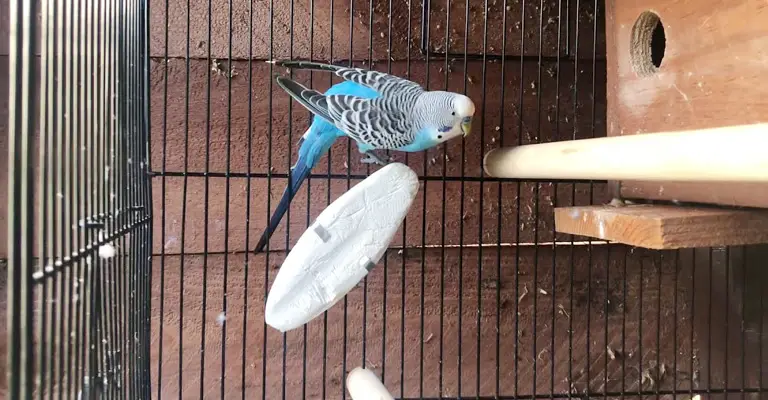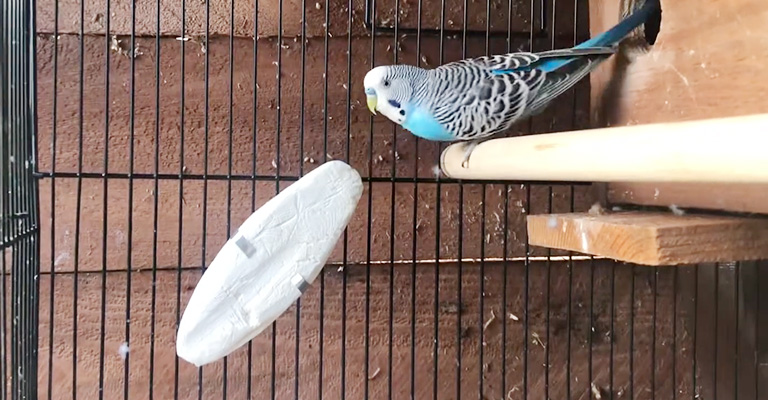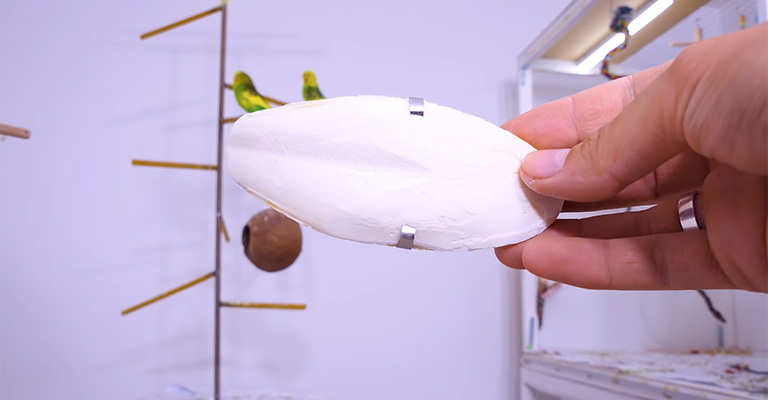A cuttlebone, though seemingly unassuming, plays a pivotal role in the health and well-being of budgies, those delightful and sociable small parrots often cherished as household pets.
But what exactly is a cuttlebone, and what is a cuttlebone, and why do budgies need them?
A cuttlebone is a flat, hard structure derived from the internal shell of cuttlefish, marine cephalopods.
It is predominantly composed of calcium carbonate and serves as a natural repository of essential minerals. This marine treasure, when introduced into a budgie’s cage, transforms into a multipurpose tool, offering both physical and mental benefits.
In this exploration, we delve into the significance of cuttlebones in a budgie’s life. We uncover nine compelling reasons why these avian friends need cuttlebones, from calcium supplementation to beak conditioning and mental stimulation.

What Is A Cuttlebone?
A cuttlebone is an interesting object that has many uses and benefits for both humans and animals. Here are some interesting facts about it:
Natural Calcium Source
A cuttlebone is a hard, flat, and oblong structure found in the bodies of cuttlefish and marine cephalopods related to squids and octopuses. It serves as a natural reservoir of calcium and other minerals.
This calcified internal shell is buoyant and helps the cuttlefish control its buoyancy in the water.
Avian Dietary Supplement
Cuttlebones are commonly used as dietary supplements for pet birds, particularly parakeets, cockatiels, and budgerigars.
These small, flat structures are rich in calcium carbonate, providing essential minerals that aid in maintaining strong beaks and healthy bones in captive birds.
Beak Conditioning
Birds, like parrots and budgies, have continuously growing beaks. Gnawing on a cuttlebone helps trim and condition their beaks.
It provides a safe and natural way for them to wear down their beaks and prevent overgrowth, which can lead to health issues.
Mental Stimulation
Offering a cuttlebone to your pet bird not only supports their physical health but also provides mental stimulation.
Birds enjoy pecking, nibbling, and exploring objects, and the texture of the cuttlebone engages their beak and keeps them entertained.
Easy Access and Consumption
Cuttlebones are readily available in pet stores and are easy to attach to a bird’s cage.
They can be hung or placed inside the cage for your feathered friend to access whenever they wish. Birds typically self-regulate their intake of cuttlebone, consuming what they need.
A cuttlebone is a natural source of calcium commonly used as a dietary supplement and beak conditioner for pet birds.
It offers a practical way to support their health, provide mental stimulation, and ensure their beaks remain in good condition.
Why Do Budgies Need Cuttlebone?

Budgies, like many pet birds, benefit from having a cuttlebone in their cage for various reasons.
Here are some important reasons why budgies need cuttlebone:
Calcium Source
Cuttlebones are a rich source of calcium carbonate, a vital mineral for budgies. Calcium is crucial for maintaining strong bones and beaks. Budgies need a steady supply of calcium for overall skeletal health.
Beak Maintenance
Budgies have continuously growing beaks that require regular maintenance. Cuttlebones provide a safe and natural way for budgies to trim and condition their beaks.
Chewing on the cuttlebone helps prevent overgrown beaks that can hinder eating and cause discomfort.
Dental Health
Just like beaks, a budgie’s dental health is closely linked to its diet. The abrasive texture of the cuttlebone aids in keeping the beak and oral tissues healthy by reducing the risk of dental issues.
Nutritional Supplement
Besides calcium, cuttlebones contain other essential minerals like magnesium and zinc, which contribute to a balanced diet for budgies. These minerals are crucial for various bodily functions, including muscle and nerve function.
Mental Stimulation
Cuttlebones offer budgies a form of mental stimulation. They enjoy pecking and exploring objects, and the cuttlebone’s texture engages their beak and provides a source of entertainment, which can reduce boredom.
Natural Instinct
In the wild, budgies would naturally encounter cuttlefish bones, and it’s part of their natural behavior to nibble on such objects. Providing a cuttlebone allows them to express these natural behaviors in captivity.
Egg Production
For female budgies that are breeding or laying eggs, the extra calcium from a cuttlebone is crucial. It supports the development of strong eggshells, reducing the risk of brittle or fragile eggs.
Stress Reduction
Chewing on a cuttlebone can be a soothing activity for budgies. It helps alleviate stress and anxiety, which is especially important for birds kept in captivity.
Easy Access
Cuttlebones are readily available in pet stores and are simple to attach to the cage. Budgies can access them whenever they want, allowing them to regulate their calcium intake as needed.
Cuttlebones are an essential addition to a budgie’s cage, providing numerous benefits ranging from calcium supplementation for bone and beak health to mental stimulation and stress reduction.
These small, inexpensive items are a valuable part of a budgie’s overall well-being and should be provided regularly.
How Do You Prepare Cuttlebone For My Budgies?

I can help you with some techniques to prepare cuttlebone for your budgies. Cuttlebone is the internal shell of the cuttlefish, an aquatic mollusk that has a high calcium content.
Here are some techniques to prepare cuttlebone for your budgies:
Buy A Cuttlebone From A Pet Store
This is the easiest and most convenient way to get a cuttlebone for your budgies. You can find cuttlebones in most pet stores that sell bird supplies.
They are usually sold in plastic packages or wrapped in paper. You can choose a cuttlebone that suits the size and preference of your budgies.
Boil A Cuttlebone In Water
If you want to sanitize and soften a cuttlebone before giving it to your budgies, you can boil it in water for about 10 minutes.
This will kill any bacteria or parasites that may be present on the cuttlebone and make it easier for your budgies to chew on it.
You can also add some vinegar or lemon juice to the water to remove any unpleasant smell or taste from the cuttlebone.
Dry A Cuttlebone In The Sun
If you want to preserve and harden a cuttlebone, you can dry it in the sun for a few hours or days.
This will remove any moisture from the cuttlebone and make it more durable and crunchy for your budgies. You can also bake a cuttlebone in the oven at a low temperature for about an hour to achieve the same effect.
Cut A Cuttlebone Into Smaller Pieces
If you have a large cuttlebone that is too big for your budgies, you can cut it into smaller pieces using a sharp knife or scissors. This will make it easier for your budgies to handle and consume the cuttlebone.
You can also use a grater or a blender to shred or powder a cuttlebone into fine particles that you can sprinkle on your budgies’ food or water.
Attach A Cuttlebone To The Cage
If you want to make a cuttlebone accessible and visible to your budgies, you can attach it to the cage using a metal clip or a wire.
You can place the cuttlebone near a perch or a toy that your budgies like to encourage them to use it.
You can also hang a cuttlebone from the top of the cage using a string or a chain to make it more fun and challenging for your budgies.
Wrap A Cuttlebone In Leafy Greens
If you want to entice your budgies to try a cuttlebone, you can wrap it in leafy greens such as lettuce, kale, or spinach.
This will make the cuttlebone more appealing and nutritious for your budgies, as they will get some vitamins and minerals from the greens as well as the calcium from the cuttlebone.
Stick Some Seeds Or Millet On A Cuttlebone
If you want to reward your budgies for using a cuttlebone, you can stick some seeds or millet on it using some honey or peanut butter.
This will make the cuttlebone more tasty and attractive for your budgies, as they will get some of their favorite treats along with the benefits of the cuttlebone.
You can also use other foods that your budgies enjoy, such as cheese, egg, or yogurt.
Play With A Cuttlebone With Your Budgies
If you want to bond with your budgies and teach them how to use a cuttlebone, you can play with it with them using your hands or fingers.
You can hold the cuttlebone near their beaks and gently tap or scratch it to show them how to nibble on it. You can also praise and reward them for showing interest or curiosity in the cuttlebone.
Replace An Old Cuttlebone With A New One
If you want to keep your budgies healthy and happy, you should replace an old cuttlebone with a new one every few weeks or months.
This will prevent the cuttlebone from becoming moldy, dirty, or worn out, which could harm your budgies’ health or appetite.
You should also check the condition of the cuttlebone regularly and remove any sharp edges or broken pieces that could injure your budgies’ mouths or tongues.
FAQ
A cuttlebone is a hard, flat structure derived from cuttlefish. Budgies need cuttlebones because they are a rich source of calcium and other minerals, crucial for maintaining strong bones, healthy beaks, and overall well-being.
Simply attach the cuttlebone to your budgie’s cage using a clip or holder. Place it where your budgie can access it easily.
Budgies typically self-regulate their cuttlebone consumption, so it’s unlikely they will overindulge. However, always ensure the cuttlebone is fresh and clean to avoid any contamination.
Mineral blocks or calcium supplements designed for birds can be alternatives. However, cuttlebones are a natural and widely accepted choice among budgie owners.
Replace the cuttlebone when it becomes worn or depleted, typically every few weeks to months, depending on your budgie’s consumption. Fresh cuttlebones ensure your budgie receives the best mineral benefits.
Conclusion
In the intricate tapestry of budgie care, the humble cuttlebone emerges as a cornerstone, ensuring the overall vitality and contentment of these delightful avian companions.
The question of what a cuttlebone is and why budgies need it is answered with a resounding affirmation of its significance.
From providing essential calcium for bone health to facilitating beak maintenance and dental care, cuttlebones are indispensable. Moreover, they offer mental stimulation, alleviate stress, and honor the budgies’ natural inclinations.
As we embrace the responsibility of caring for these small but spirited creatures, the inclusion of a cuttlebone in their environment becomes not just a choice but a commitment to their health and happiness.
So, let us continue to adorn budgie cages with this unassuming yet invaluable gift from the ocean, acknowledging the profound impact it has on the lives of our beloved feathered friends.